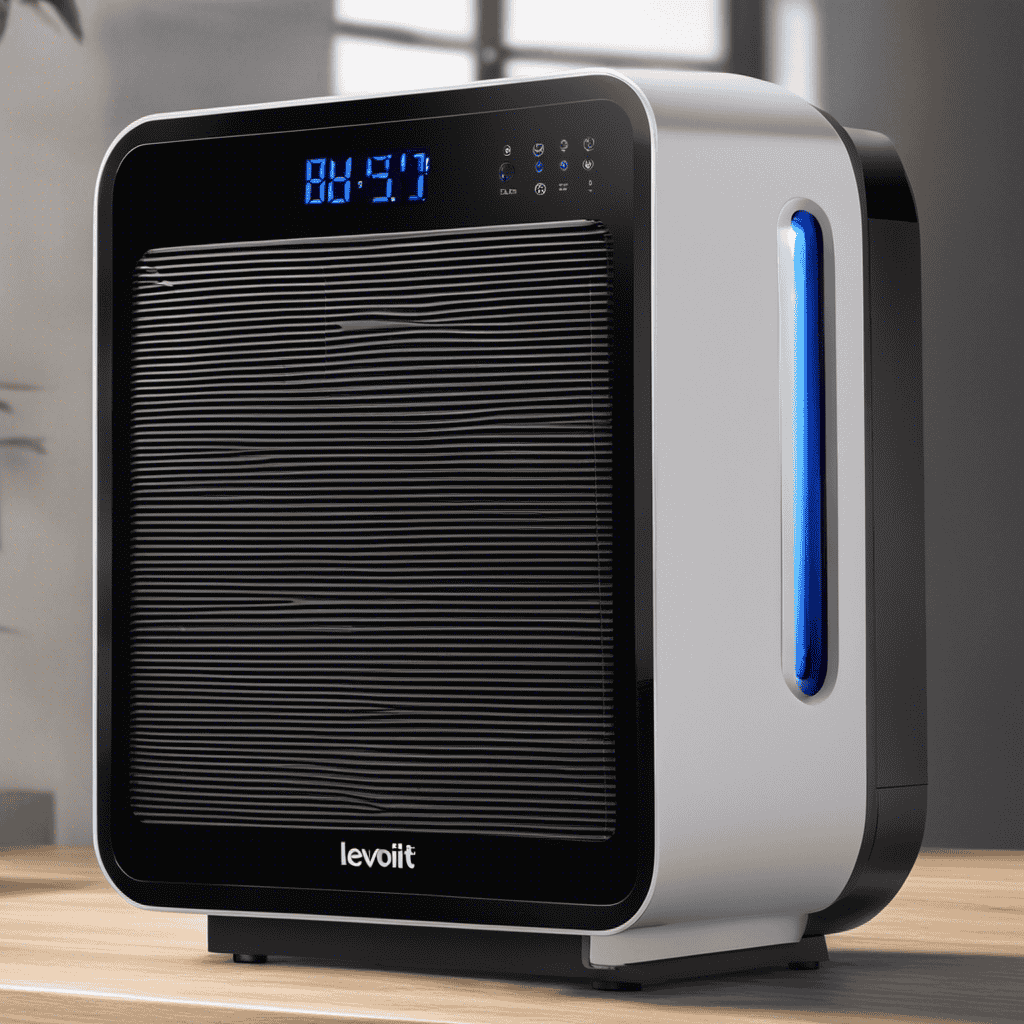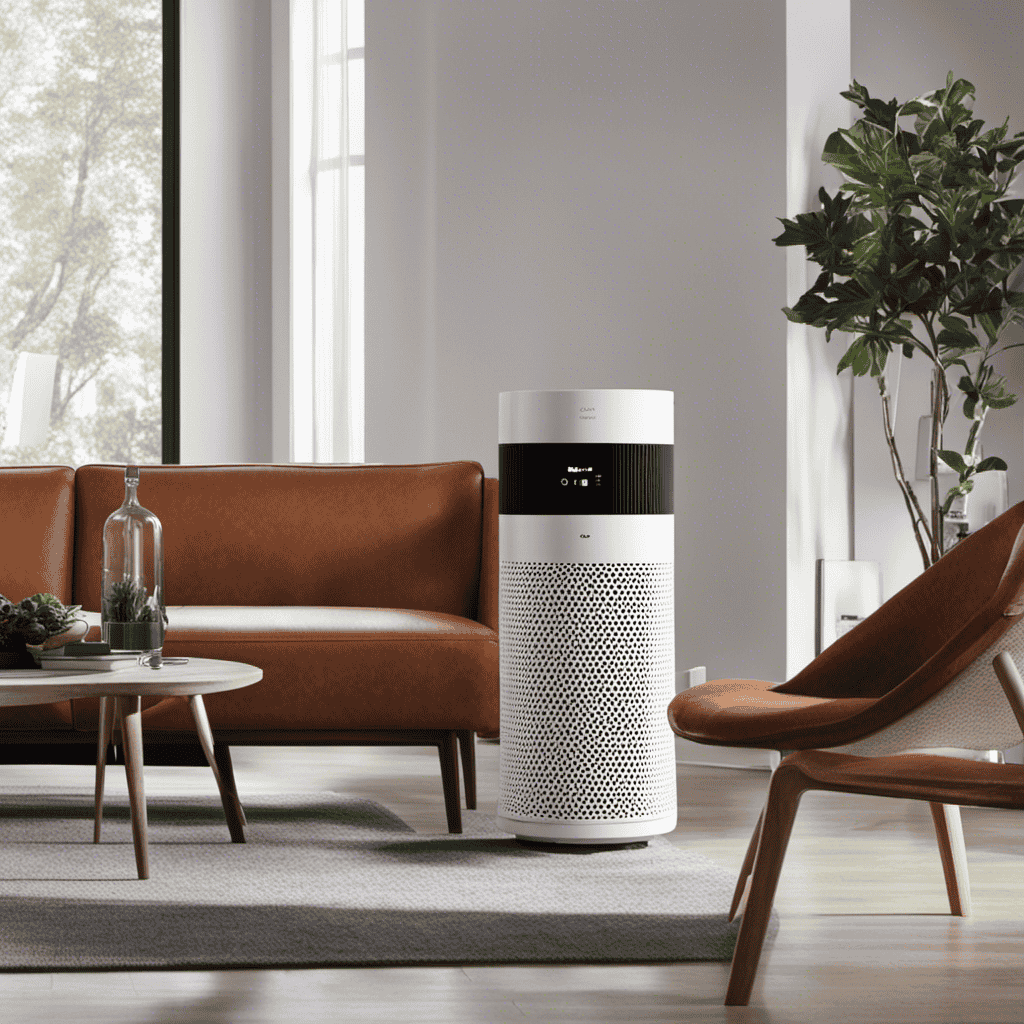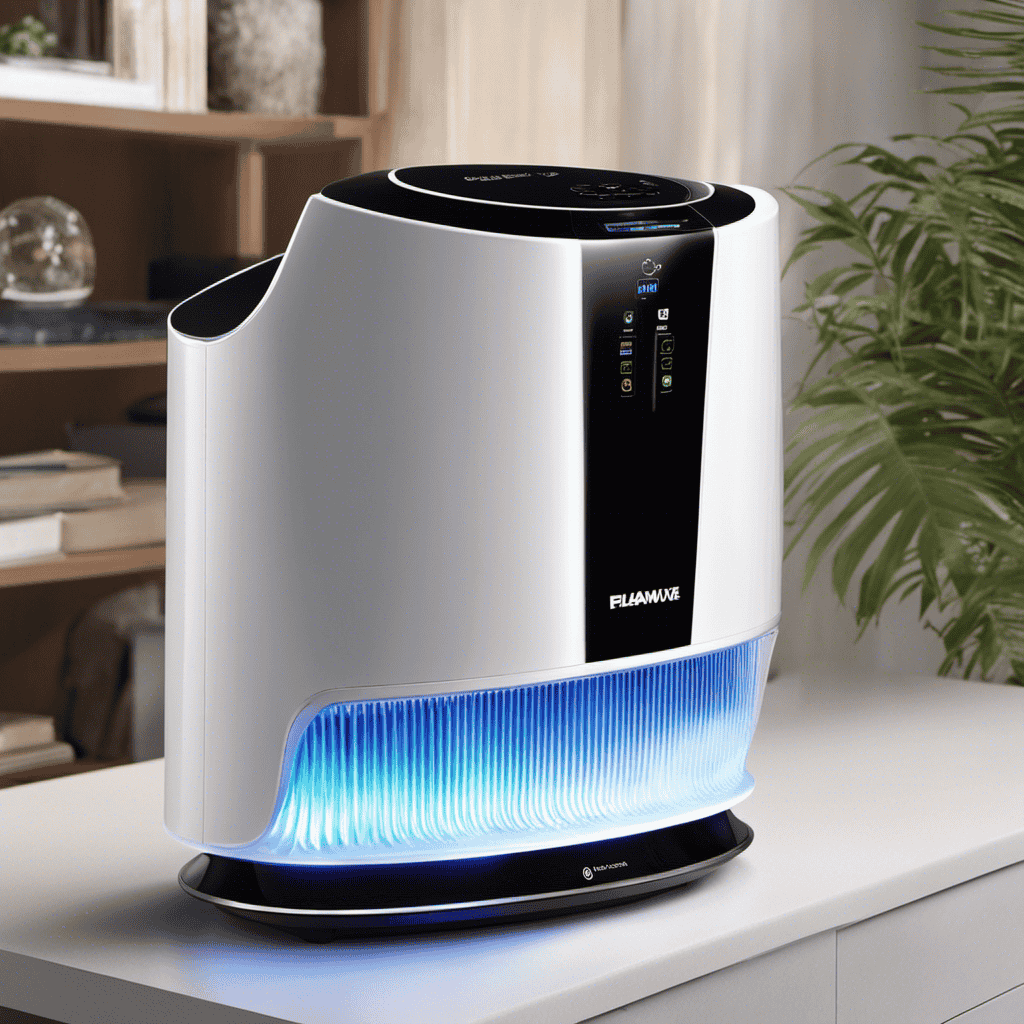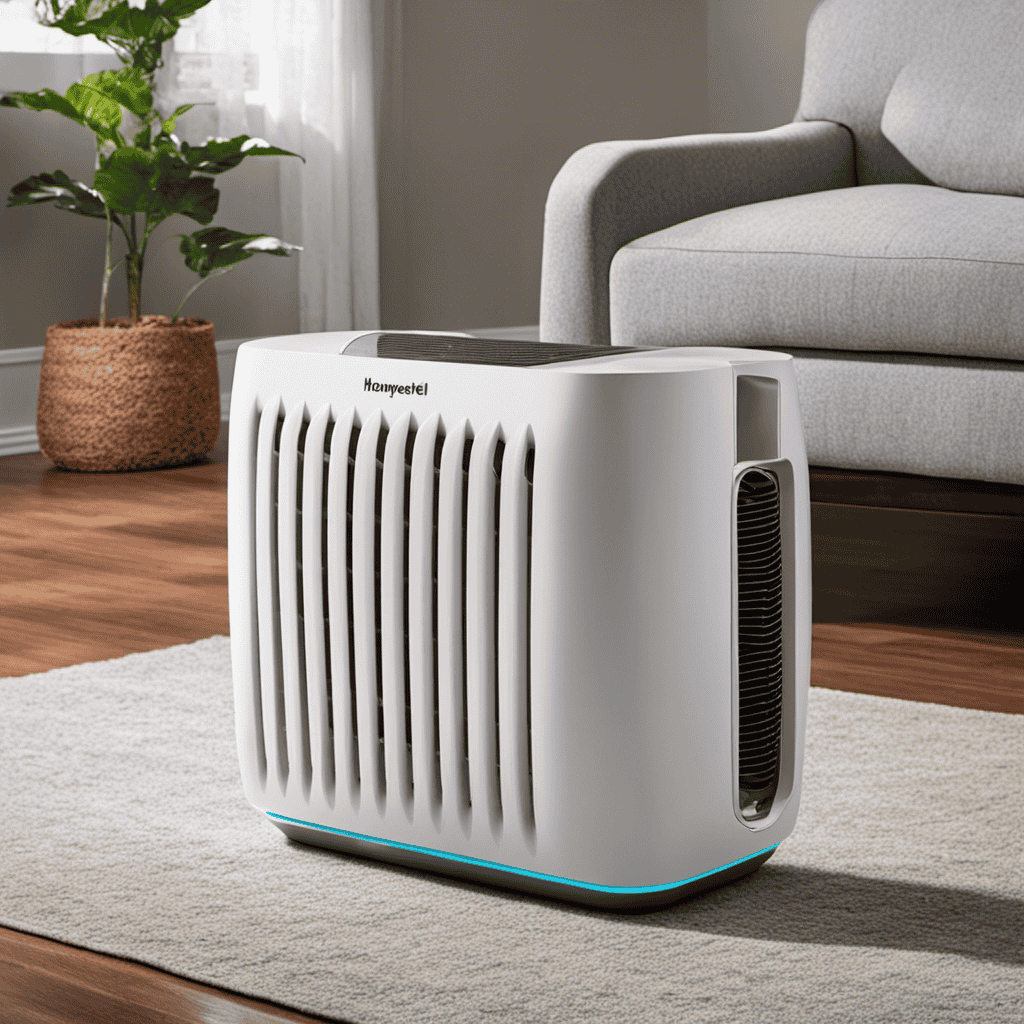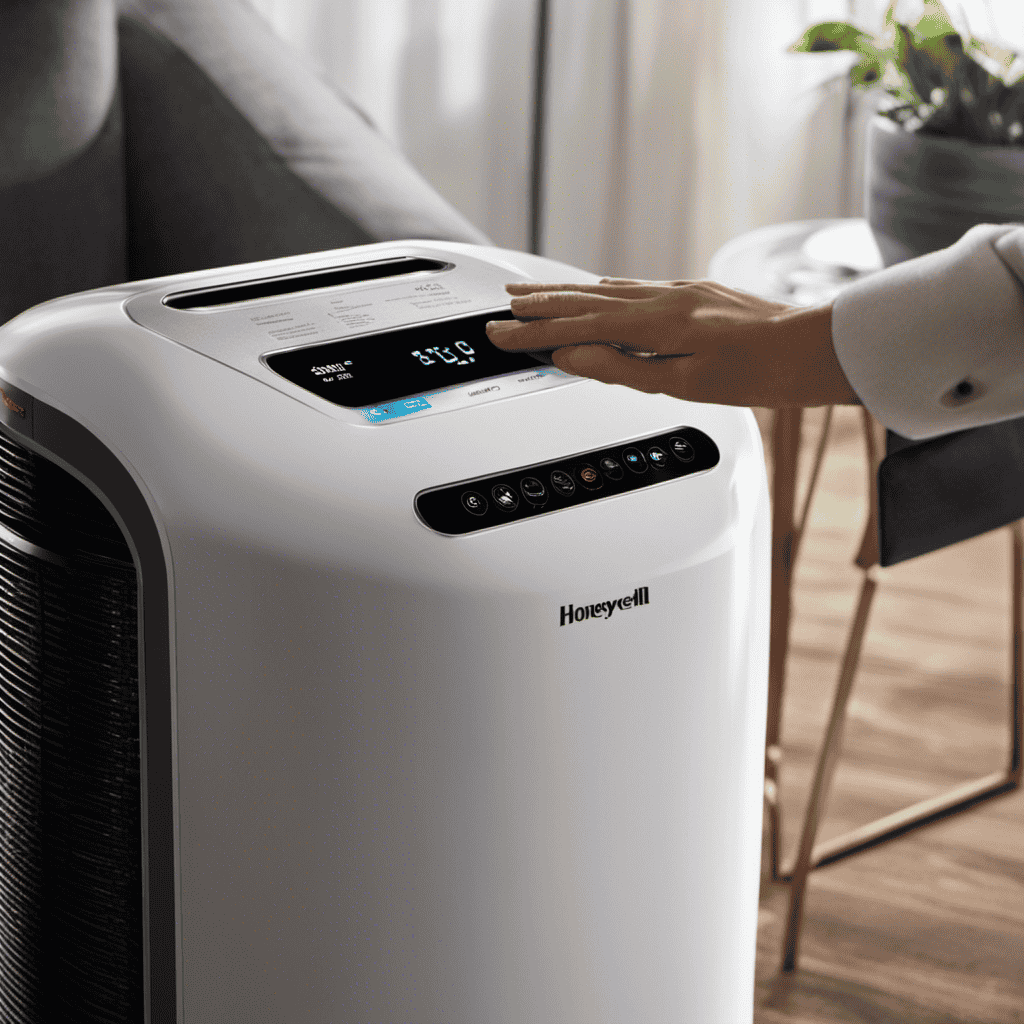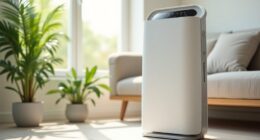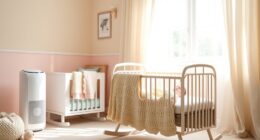Standing in my house, inhaling deeply, I find myself contemplating the unseen particles that are suspended around me. How can I make certain that the air filling my lungs is pure and conducive to good health?
Enter the Levoit Air Purifier, a powerful device that promises to improve air quality. But what do those numbers mean?
In this article, I will delve into the technical details and decipher the significance behind the Levoit Air Purifier’s numbers, giving you a deeper understanding of its performance and capabilities.
Key Takeaways
- The CADR rating measures the air purifier’s ability to filter out pollutants, so look for high CADR ratings for smoke, pollen, and dust for efficient filtration.
- The ACH rating indicates how many times the air purifier can filter the entire room’s air volume in an hour, so higher ACH ratings mean more frequent air cleaning and reduced pollutant concentration.
- Filter efficiency refers to the percentage of particles the air purifier can remove from the air, and regularly replacing filters is crucial for maintaining the air purifier’s efficiency.
- The noise level of air purifiers can be evaluated using the decibel (dB) rating, and lower dB numbers indicate quieter operation. Adjustable fan speeds and sleep modes can help customize noise levels.
The Importance of Air Quality Measurements
You should pay attention to the numbers on your Levoit air purifier because they indicate the air quality measurements.
Monitoring air quality in the home is crucial for maintaining a healthy environment. Research has shown a strong correlation between air quality and health. Poor air quality can lead to respiratory problems, allergies, and even more serious conditions such as asthma and cardiovascular diseases.
By monitoring the air quality in your home, you can take necessary measures to improve it and protect yourself and your family. The benefits of monitoring air quality include reducing the risk of respiratory illnesses, improving sleep quality, and enhancing overall well-being.
The numbers on your Levoit air purifier serve as a valuable tool to help you track and maintain a healthy indoor environment.
Understanding the Air Purifier’s CADR Rating
To understand the CADR rating of an air purifier, start by looking at the numbers on the product. The CADR (Clean Air Delivery Rate) is a measure of how effectively an air purifier can filter out various air pollutants. Here are four key things to consider when comparing air purifier models:
-
CADR for different pollutants: The CADR rating is usually given for three types of pollutants – smoke, pollen, and dust. Look for an air purifier that has high CADR ratings for all three pollutants to ensure efficient filtration.
-
Room size coverage: The CADR rating is also associated with a specific room size. Make sure to choose an air purifier that matches the size of the room you intend to use it in.
-
Comparing CADR ratings between models: When comparing air purifier models, focus on the CADR ratings rather than the overall size or price. Higher CADR ratings indicate better performance in removing air pollutants.
-
Personal needs and preferences: Consider your specific needs and preferences when comparing air purifiers. For example, if you have allergies, look for an air purifier with a higher pollen CADR rating.
Understanding the CADR rating is just one aspect of choosing the right air purifier. Now, let’s delve into decoding the air purifier’s ACH rating and how it relates to the overall air cleaning efficiency.
Decoding the Air Purifier’s ACH Rating
Decoding the air purifier’s ACH rating can provide valuable insights into its overall air cleaning efficiency. ACH stands for Air Changes per Hour, which measures how many times an air purifier can filter the entire volume of air in a room within an hour.
To achieve effectiveness and maximize performance, it is crucial to understand this rating. A higher ACH rating means the air purifier can clean the air more frequently, reducing the concentration of pollutants. For example, an ACH rating of 4 means the air purifier can filter the air in a room four times every hour. This information helps determine the appropriate size and placement of the air purifier for different room sizes.
Now let’s move on to interpreting the air purifier’s filter efficiency, which plays a vital role in its overall performance.
Interpreting the Air Purifier’s Filter Efficiency
Understanding the air purifier’s filter efficiency is essential for determining its overall performance. The filter efficiency refers to the percentage of particles that the air purifier can remove from the air. Interpreting the air purifier’s performance based on its filter efficiency can help you understand how effectively it can improve the air quality in your space.
Here are four key points to consider:
-
Filter Type: Different air purifiers use different types of filters, such as HEPA filters or activated carbon filters. Each filter type has a different efficiency level in capturing specific pollutants.
-
MERV Rating: The Minimum Efficiency Reporting Value (MERV) rating indicates the filter’s ability to trap different-sized particles. The higher the MERV rating, the more efficient the filter is at removing smaller particles.
-
CADR: The Clean Air Delivery Rate (CADR) measures the air purifier’s ability to remove common indoor pollutants, such as dust, pollen, and smoke. Higher CADR values indicate better filtration performance.
-
Filter Replacement: Regularly replacing the air purifier’s filters is crucial to maintaining its efficiency. Understanding the manufacturer’s recommended filter replacement schedule is essential for optimal performance.
Analyzing the Air Purifier’s Noise Level
When choosing an air purifier, it’s important to consider how noisy it may be in order to find one that suits your preferences. Analyzing noise levels is a crucial aspect of measuring air quality.
In order to evaluate the noise level of an air purifier, it is necessary to look at the decibel (dB) rating. This rating measures the intensity of sound, and lower dB numbers indicate quieter operation. Many air purifiers have adjustable fan speeds, allowing you to customize the noise level based on your needs. Additionally, some models come with a sleep mode that reduces noise during nighttime use.
By analyzing the noise levels of different air purifiers, you can find one that provides the desired level of quietness while effectively improving air quality.
Transitioning to the next section, let’s now make sense of the air purifier’s power consumption.
Making Sense of the Air Purifier’s Power Consumption
To get a better understanding of how much electricity your air purifier uses, you can simply check the wattage listed on the device. The wattage will give you a clear indication of the power consumption of the air purifier.
Here are four key points to help you calculate the energy consumption and costs of your air purifier:
-
Wattage: Look for the wattage rating on the air purifier. This will tell you how many watts of electricity it consumes while operating.
-
Daily Usage: Determine how many hours per day you run your air purifier. Multiply the wattage by the number of hours to calculate the daily energy consumption.
-
Monthly Usage: Multiply the daily energy consumption by the number of days in a month to determine the monthly energy consumption.
-
Cost Calculation: Multiply the monthly energy consumption by the cost per kWh (kilowatt-hour) in your area to calculate the monthly operating cost.
Exploring the Air Purifier’s Coverage Area
If you’re wondering how much space your air purifier can effectively cover, simply check the square footage listed in the product specifications. When exploring air purifier technology and comparing air purifier models, understanding the coverage area is crucial.
The coverage area refers to the maximum size of the space in which the air purifier can effectively clean the air. It is usually measured in square feet or square meters. Different air purifier models have different coverage areas, and it’s important to choose one that matches the size of your room or space.
A larger coverage area means the air purifier can effectively clean the air in a larger space, while a smaller coverage area is suitable for smaller rooms or spaces. Therefore, when comparing air purifier models, make sure to consider the coverage area to ensure optimal air purification performance.
Evaluating the Air Purifier’s Maintenance Requirements
In my research on the Levoit air purifier, I have come across some crucial information regarding its maintenance requirements. Evaluating filter replacement and understanding maintenance costs are essential aspects to consider when investing in an air purifier.
Here are four key points to help you navigate this aspect of the Levoit air purifier:
-
Filter lifespan: The Levoit air purifier typically requires filter replacements every 6-8 months, depending on usage and air quality.
-
Filter cost: Replacement filters for the Levoit air purifier are reasonably priced, making maintenance costs manageable.
-
Ease of replacement: The Levoit air purifier’s filter replacement process is straightforward and user-friendly, requiring no special tools or technical expertise.
-
Maintenance indicators: The Levoit air purifier is equipped with maintenance indicators that alert users when it’s time to replace the filters, ensuring optimal performance.
Understanding these maintenance requirements will help you make an informed decision and plan for the long-term upkeep of your Levoit air purifier.
Frequently Asked Questions
How Does the Levoit Air Purifier Measure Air Quality?
The Levoit air purifier measures air quality using its sensor technology. It provides accurate readings and detects pollutants in the air. The numbers on the purifier indicate the level of air quality, helping users understand the cleanliness of their environment.
What Is the Significance of the CADR Rating in an Air Purifier?
The CADR rating is significant in an air purifier as it measures the effectiveness of the device in removing pollutants from the air. A higher CADR rating indicates a faster and more efficient purifying process.
How Can the ACH Rating of an Air Purifier Affect Its Performance?
When it comes to air purifiers, the ACH rating plays a crucial role in determining its performance. A higher ACH rating means better air purification, as it indicates how many times the air in a room gets filtered per hour.
What Does the Filter Efficiency of the Levoit Air Purifier Indicate?
The filter efficiency of an air purifier indicates how effectively it can remove pollutants from the air. It is a crucial factor in determining the overall performance of the purifier in maintaining clean and healthy indoor air quality.
Is There Any Correlation Between the Noise Level and the Effectiveness of the Air Purifier?
There doesn’t seem to be a correlation between the noise level and effectiveness of air purifiers. However, factors like price and room size can impact their performance. Further research is needed to determine any potential relationship.
Conclusion
In conclusion, understanding the numbers associated with a Levoit air purifier is crucial for making an informed decision about its effectiveness.
The CADR rating provides a visual representation of how quickly the purifier can clean the air in a given space.
The ACH rating helps determine how many times the air is purified in an hour, ensuring constant freshness.
Filter efficiency indicates how well the purifier removes pollutants, while noise level and power consumption are important for user comfort and energy efficiency.
Lastly, the coverage area and maintenance requirements determine the purifier’s suitability for different spaces.
By analyzing these numbers, one can make a well-informed choice and breathe in cleaner, healthier air.
